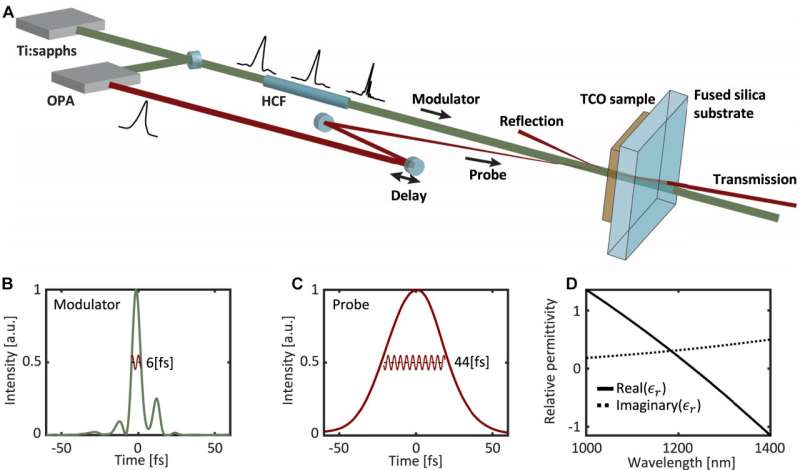This article has been reviewed according to Science X's editorial process and policies. Editors have highlighted the following attributes while ensuring the content's credibility:
fact-checked
trusted source
proofread
Photonic time crystals could open the door to a new branch of optics

Refractive index—the ratio of the speed of electromagnetic radiation in a medium to its speed in a vacuum—can be modulated fast enough to generate photonic time crystals (PTCs) in the near-visible part of the spectrum, a new study published in the journal Nanophotonics demonstrates. The study's authors suggest that the ability to sustain PTCs in the optical domain could have profound implications for the science of light, enabling truly disruptive applications in the future.
PTCs, materials in which refractive index rises and falls rapidly in time, are the temporal equivalent of photonic crystals in which the refractive index oscillates periodically in space causing, for example, the iridescence of precious minerals and insect wings.
A PTC is only stable if the refractive index can be made to rise and fall in line with a single cycle of electromagnetic waves at the frequency concerned so, unsurprisingly, PTCs have thus far been observed at the lowest-frequency end of the electromagnetic spectrum: with radio waves.
In this new study, lead author Mordechai Segev of the Technion-Israel Institute of Technology, Haifa, Israel, with collaborators Vladimir Shalaev and Alexndra Boltasseva from Purdue University, Indiana, U.S. and their teams, sent extremely short (5-6 femtosecond) pulses of laser light at a wavelength of 800 nanometers through transparent conductive oxide materials.
This caused a rapid shift in refractive index that was explored using a probe laser beam at a slightly longer (near infra-red) wavelength. The probe beam was rapidly red-shifted (that is, its wavelength increased) and then blue-shifted (wavelength decreased) as the material's refractive index relaxed back to its normal value.
The time taken for each of these refractive index changes was minuscule—less than 10 femtoseconds—and, therefore, within the single cycle necessary to form a stable PTC.
"Electrons excited to high energy in crystals generally need over ten times as long to relax back to their ground states, and many researchers thought that the ultra-fast relaxation we observe here would be impossible," Segev said. "We don't yet understand exactly how it happens."
Co-author Shalaev further suggests that the ability to sustain PTCs in the optical domain, as demonstrated here, will "open a new chapter in the science of light and enable truly disruptive applications." However, we know as little of what these might be as physicists in the 1960s knew of the possible applications of lasers.
More information: Eran Lustig et al, Time-refraction optics with single cycle modulation, Nanophotonics (2023). DOI: 10.1515/nanoph-2023-0126
Provided by De Gruyter



















